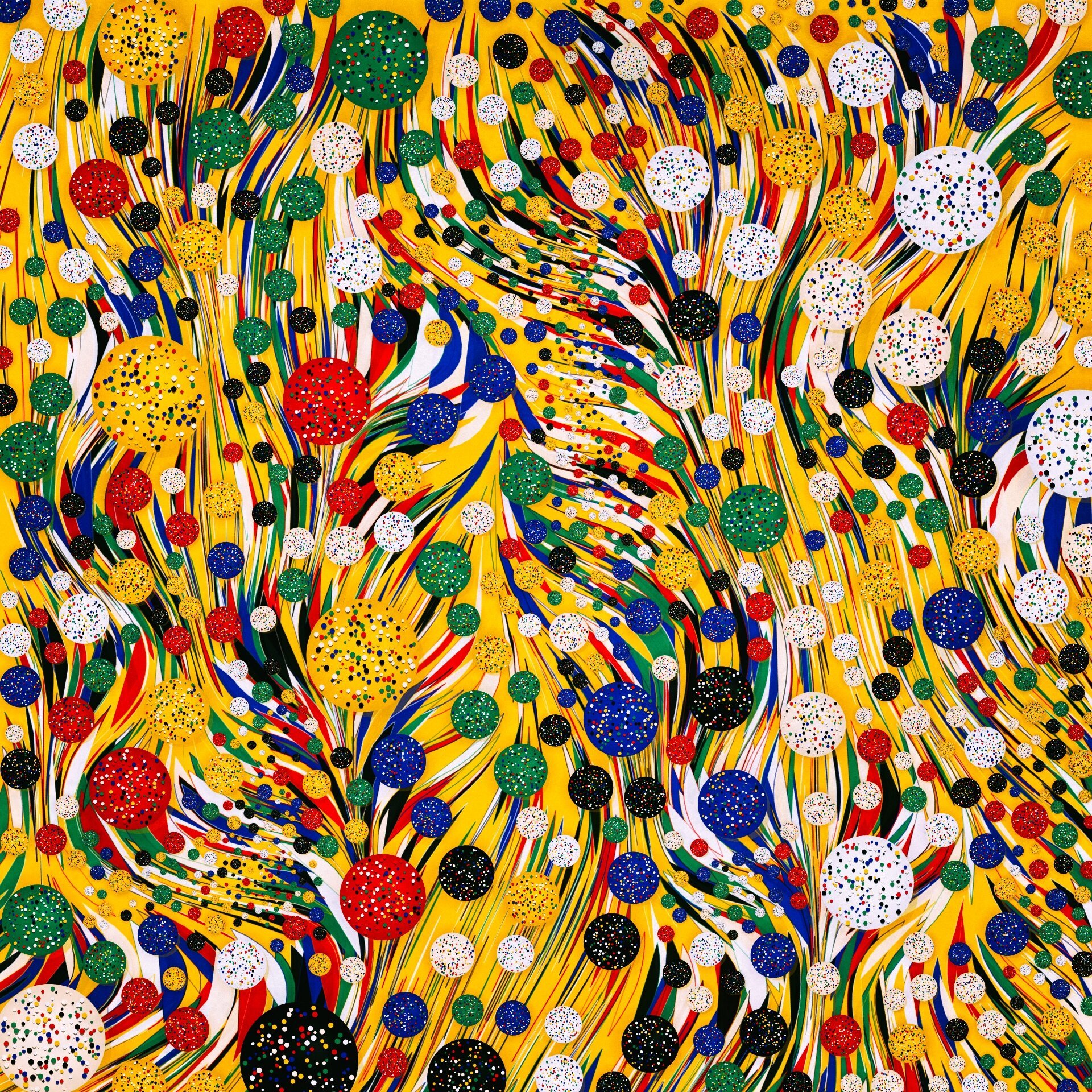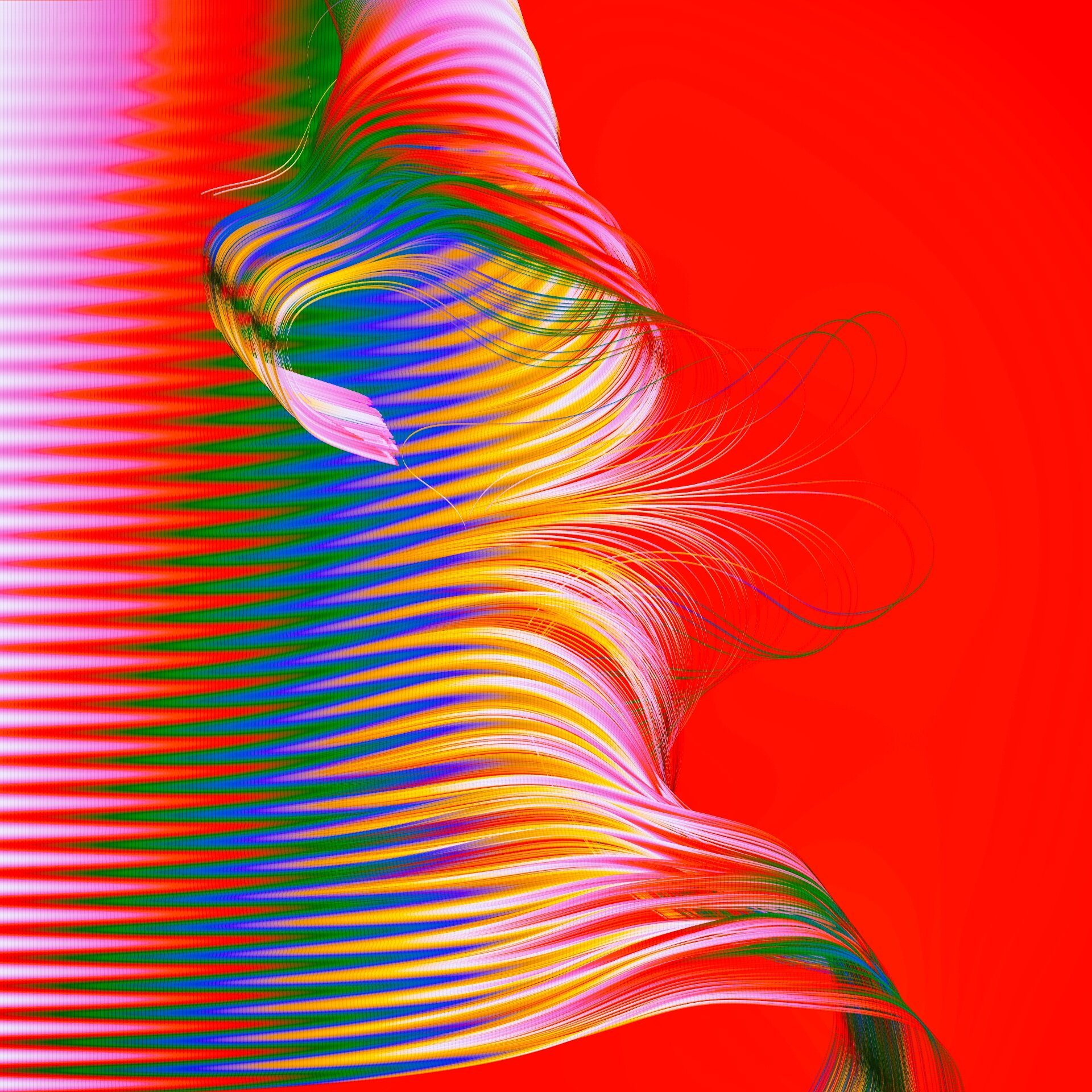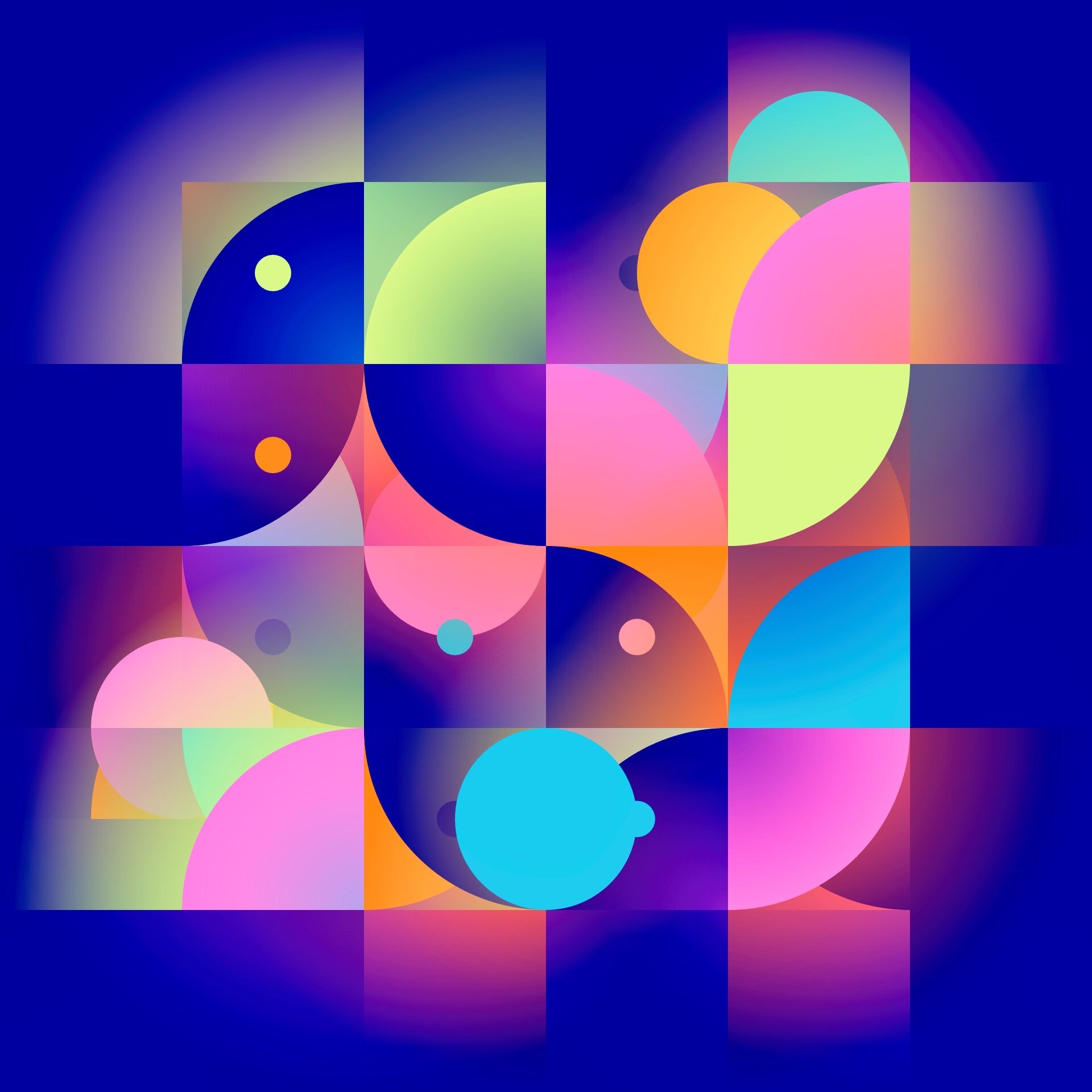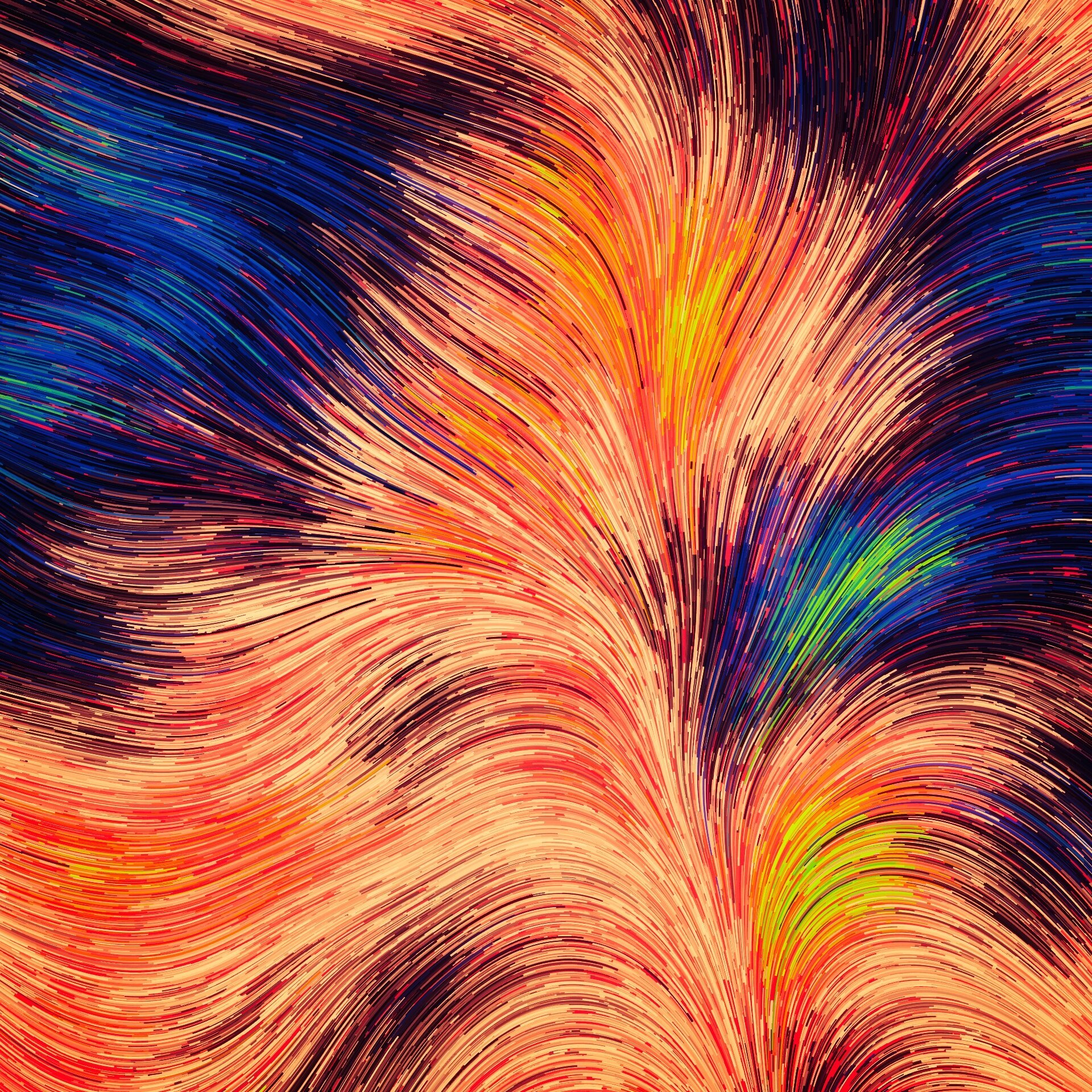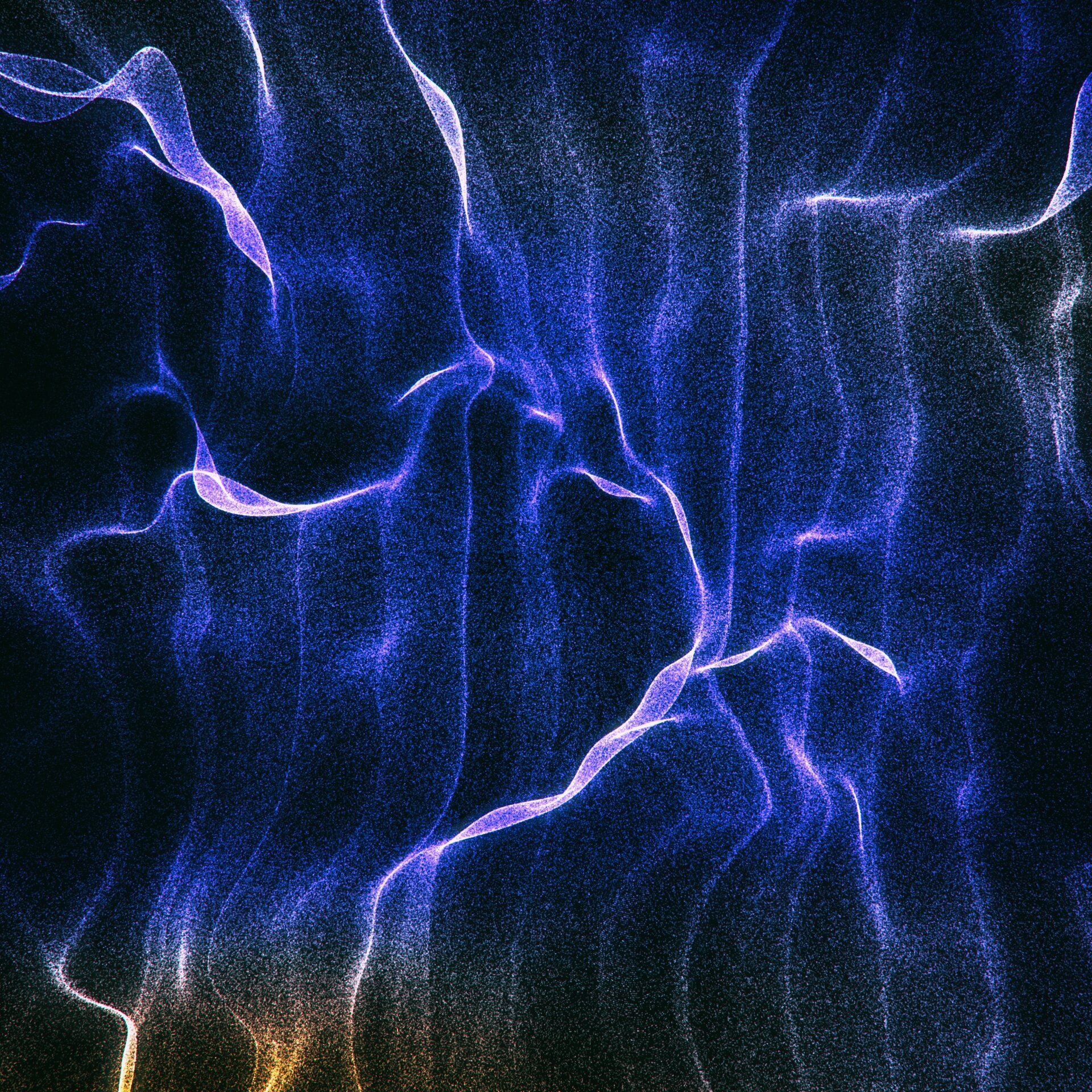'THE GENERATIVE ART THAT WEARS THE COLORS OF THE SOUL'.
Exclusive interview by Kate Vass with generative artist - Manolo Gamboa Naon, aka - Manoloide.
‘Last flowers’, 2021 by Manoloide - unique Hahnemühle Photo Rag Fine Art Print, Image 1.5x1.5 meters, unframed
"Not everyone can do what a genius can," the famous art historian Ernst Gombrich spoke, "and not everyone can produce a masterpiece even after long training." I am not a big fan of Gombrich, but I should note that his quote fits best when I refer to the generative artist from Argentina– Manolo Gamboa Naon, aka Manoloide.
In his first and last interview, published in English in 2018, Artnome refers to his artworks as 'the result of the entire contents of twentieth-century art and design being put into a blender.' I could not agree more. Looking at Manolo's creations, I feel that he combines the contemporary genius of generative art with ancient primary forms of visuals and the power of colour.
I am thankful to get to know Manolo and work with him since 2018. Since that time, there have been many developments, and I felt the importance to reach out to interview him once again after three years and speak with him about his life, Processing, and artworks. In this interview, I wish to feature a selection of 53 images cataloguing the past three years of Manolo's practice, exported between 100 and 1000 variations and filtered by the artist as his top-notch.
1 ‘Field of Poppies’, 1907 by Gustav Klimt I 2 ‘Cllm’, 2019 by Manoloide I 3 Fragment from 'The Poppy Fields near ‘Argenteuil', 1873 by Claude Monet
The cultural scene initially rejected generative art for many years. Nevertheless, we know many non-computer related talents without whom we cannot imagine art history nowadays. Artists such as François Morellet, Hans Haack, Sol LeWitt or Ellsworth Kelly. The last was one of the forerunners of generative art; Kelly used to create paintings using random operations to assign colours to the grid and works on paper, which was then cut into strips or squares and assembled using random operations to determine the placement. Sol LeWitt created generative art in the form of systems expressed in natural language and geometric permutation systems. Many more predecessors of conceptual art led to the acceptance of generative art, therefore of computer art. That is probably linked to the increased accessibility of technology and its common use in everyday life in the last two decades. As generative art is commonly described as 'algorithmic art' (made using a predetermined system), it often has an element of Randomness. It is often accused of lacking the value of artwork by questioning its creator. I tend to disagree with this accusation. As Manolo's example shows, many have access to the open-source code and know Processing, but only he creates such masterpieces, diverse in composition and colour. Regardless of the tool that the artist uses, whether it's a digital paintbrush or code, only his genius has the power to move simple forms into a composition that none of us even have ever imagined.
Manolo was always interested in Randomness. By integrating chance into a piece of code art, one receives a unique artwork each time one runs the script. I remember his quote from the first interview: "when I come and create, the most beautiful parts of the work are born from the errors. After a certain point, I believe that the maturity of my style was formed by making small errors because I was discovering as I went along. From these errors, I take an idea, and it stays. I learn how to manipulate these errors. The error is central to the work of generative artists apart from, obviously, the rules. The rules become a text that converts into an image. It is impossible to have what you imagine become what you see. The beginning is errors, errors, errors, errors. They are beautiful errors."
The philosophy of generative art is so deep; to me, it replicates life itself. From our mistakes, we learn, and mistakes/errors make our lives more stimulating. From choices and decisions – we let the universe write its code. Technically, the whole civilization as we know it - is one giant artwork generated by the universe.
1 ‘Untitled (Multiform)’ by Mark Rothko (1948, oil on canvas), copyright: ARS, NY Kate & Christopher Rothko I 2. ‘Inside’, 2019 by Manoloide
While preparing for this interview, I could not help but notice by looking through Manolo's works for the last three years - it unintentionally inflames the viewer to dig into his 'connaissance' of the history of art, each image is unique in colour, style, and composition may remind you of some famous paintings. I, e.g., see the resemblance of some masterpieces by Klimt, Monet, Rothko, Ad Reinhardt, Eyvind Earle's and many more great artists. The more you browse through Manolo's artworks, the more it captures your attention and challenges you to know the whole spectre of art genres, as you can find images so unlike in style: from Impressionists and Abstract to Kinetic and Illustrative Design. On the other hand, generative art always tends to draw inspiration from modern art, particularly pop art, where geometric patterns are standard. The basic Geometry, Algorithm, and Randomness are the three main components of the regular generative artist. Manolo's use of geometric shapes and patterns are worth noting. But, to me, the colours that he mixes in the extraordinary chaos – this is a true revolution! Manolo brings colour as the fourth element to generative art practice, which the majority usually ignore.
1 ‘Miedo’, 2018 by Manoloide I 2 ‘tratab’, 2019 by Manoloide
The richness of colours impresses and captures. In the work cllm, you see Manolo dilutes the contours and constructs a colourful rhythm with red and purple drops. Pure impressionism, and at the same time - a step to abstraction art. Looking at the other work tratab, 2019 - the constructivism of colour, exposure of architecture of simple geometric shapes combined in complex dance provokes you to feel a strong spiritual connection to science and art. Doesn't it? Imagine all his works in monochrome colours. Would you feel the same way looking at it? The power of colour is inevitable. Colour moves your reactions often on a deeply personal level. A particular colour can calm your nerves, agitate, motivate and empower you to take action, and carry healing energy when you look at it. As Wassily Kandinsky proclaimed, "Color provokes a psychic vibration. Colour hides a power still unknown but real, which acts on every part of the human body." Manolo proves this statement well with his colourful art.
1 ‘Magical Forests’ by Eyvind Earle I 2 ‘Monta’, 2020 by Manoloide I 3 ‘Sanctuary’ by E.Earle
Another artwork that strikes my attention is Monta, 2020. Unlike many others, the choice of colour pallet inspired by famous illustrator Eyvind Earle stands along with many of Earle's famous works. The bizarre choice of some colours, taken to the extreme of their saturation, makes Manolo's landscapes in 'Monta' pleasant to the eye. It has been said that Leonardo da Vinci preferred to meditate in a lavender or purple-coloured light. Same colours that we see in Monta, I also find very meditative.
To conclude, Manolo’s style is simply unique, synthesis is the main balance of his technique.
Before starting the interview, I'd like to thank Sofia Crespo, another talented generative artist. She has helped with some translation from my far-from-perfect Spanish during our long zoom conversations with her and Manolo. I also want to thank Manolo for agreeing to publish this material. I hope you will enjoy the interview, and you will enjoy browsing through 53 works that have been selected in the gallery attached.
KV: The First and last interview in English was concluded by Artnome back in 2018, and since then we have had many changes. You have participated at various art exhibitions and moved to Germany and then again back to Argentina. Could you tell us more how these 3 years have been for you? The interesting turn was when you also took a sabbatical year from the art scene last year. What was the main reason and how do you feel about this?
MG: The last 3 years I've been living many different experiences and circumstances, although much of my life happened on a more mental level and on my computer. I went from living with one backpack to two and a suitcase, changed home more than 20 times, building new routines is something I enjoy. In 2019 I went to Germany to work in one of my favorite studios. I felt stimulated and supported, this allowed me to focus a lot on my work and life in Berlin flowed, with the months I started to understand some English, but I also enjoyed a lot living in silence. In 2020 I came back to Argentina for a few months with the idea of concentrating on my projects, then COVID happened and I felt a bit locked in myself, over stimulated by the internet. I stopped being on the computer all day, I didn't code for several months, I closed my social networks, turned off my cell phone, and suddenly I was full of emptiness which I was filling with new routines playing outside the screens; I enjoyed reading, going back to study more freely as I did before, playing the piano, drawing and doing physical activity. It was a necessary process to get out of a depression, reconnect with my body, take distance from my work and what was happening.
KV: We share here around 53 images that you have selected as 'best works 'for the last 3 years, and we see some changes in the compositions and some or the images seem like a dreamland. What do you feel code gives you?
MG: At the beginning of this year I started to catalogue and order my work, I had never taken a moment to analyze the projects I had worked on. I made a selection of the 53 series that most attracted me visually, exported between 100 and 1000 variations and filtered them until I was left with one per series. I use the code as a tool, but also as a language where I can represent very diverse ideas: sometimes I am only interested in solving a geometry problem, exploring how colours blend, give the sensation of a material, a pattern on the floor, how to represent a tree.. the most beautiful thing is when the idea is close to a feeling.
1 ‘pparappar’, 2019 by Manoloide I 2 ‘Mantel Blue’, 2018 by Manoloide
KV: Many of your works, particularly from 2018 contain circles. By looking at the Mantel or ppraparr , one can dive into the image and circle around with the imagination, surrounded by powerful colour palettes that strike me. Does it happen intuitively, that you have been creating circles, and more circles around, can I compare it with a meditative process of 'monks' meditation?
MG: In 2018 I was really in love with my work and my process, I spent almost all day focused on that, a constant exploration. I feel that those deep connections are very similar to meditation; after a lot of time of routine and exercise, you can stop thinking, the ideas flow and you don't pause to question or analyze them. Mantel is an automatic piece, I had no thoughts when I made it. I love circles, many of the series are just circles, they can really represent very different ideas, the most magical thing is when they are camouflaged.
KV: What is about writing or mixing the code that fascinates you the most? It's known fact that the Processing is not new per se, and that this code is open for public, nevertheless your work is so strong and easily recognisable among millions of other artists using same processing technique. Do you sketch the ideas or what is your approach when you create the work? Do you imagine the image before you start or do you write the natural code (Pseudocode) ?
MG: I think the code gives me precise boundaries, I can only write and see what happens. Then you imagine, write, observe, this is constantly repeated. I prefer to have a fuzzy idea or a trigger, the ideas in my mind are pretty, but when I have a very specific or complex one, I tend to get disappointed in the process. I can just write and see what happens, in general I draw some random dots, a big spot and try to control it, or I draw the figures shape by shape. I start from something simple, see what happens and add another idea. After several iterations I usually come up with images of the dialogue with the process that evokes something in me.
‘arbolito’, 2018 by Manoloide
KV: When we look at the landscape image monta, 2020 or arbolito2, 2018 or : I wonder which forest/field or place served as inspiration to you?
MG: I never lived in the forest or near the mountains - it is something that at some point I would like to experience, but I grew up surrounded by trees and plants, "arbolito2" reminds me of the trees I grew up with in my mother's house. "Monta" is an image that was in my head for several years, as much of my work is a set of references, the structure is a copy of Eyvind Earle's work, an artist who involves me in his moods. But above all, my mental image is of the forests of Japan, a place I've never been to, but it is very close to how I imagine it. Something similar happens with "cllmt", for a long time I wanted to depict Gustav Klimt's flower landscapes, the feelings are not the same as what I want, but they are close to it. I don't usually take vacations or visit places, so my references are usually images made by others (photographs, paintings, books). Trees/plants/flowers, on the other hand, are usually my strongest connection to nature, I take walks, I really enjoy seeing and contemplating them, they are beautiful systems, totally exposed.
Feral File project (screen shot)
KV: Recently you have participated at Feral File exhibition, how did you like the experience and what did you find challenging?
MG: I felt a great motivation to participate in Feral File with artists that I have lived with on the internet for many years. To me, Casey Reas built a place (Processing) and I really enjoy his work, he is a sensitive and fine artist. It was a difficult process to get back to coding after months, I'm usually very self demanding, I'm never satisfied and even less when I know it's going to be exhibited; it was difficult, I spent many weeks working on "uneasy dream", fighting with my head, trying to find something.. it's the published project I worked on the longest, I started to live at night, I stopped sleeping. I like to play with my mind, but it wasn't a good way, I was angry with myself, I think some of those things are visible, so now I'm happy with it.
KV: As far as I know you also play piano and write/read poetry and draw by hand. Which process do you enjoy the most and do you get inspired by practicing piano ,for example, to create a work with Processing?
MG: I always like to study and do multiple things, they may not have an evident connection but I feel that all the things I learn end up merging in my mind. Something happens with Processing, it's the only tool with which I managed to move myself or feel something interesting enough. I spent many hours making music, drawing, playing with software, but I never found such an intense way of satisfaction. But keeping several different projects and processes and jumping from one to another always helped me to stay active.
KV: How would do you feel about NFTs and its trend?
MG: It is difficult for me to have a clear idea, many contradictions arise as with cryptocurrencies, they're the things in which I am immersed but I really do not understand nor they interest me. I wish I could not believe in contracts, nor the idea of property, nor money, nor individual development, I say, it is something that touches too many models that exceed me. I was happy for many friends and artists, the visibility of digital art, I feel that there are many more people exploring this. I'm not usually interested in what happens when something is trending but I'm curious to see how it evolves in the coming years.
KV: What is your biggest challenge and what is the work of your dreams that you still wish to create?
MG: I usually live in dreams that vary constantly so my ideas change, but it is an adaptation to the context. I would like to eliminate the words, the ideas. Fall in love with a language again and explore it freely in my mind. Learn to enjoy slow processes without expecting so much for results.
KV: I would like to thank once again, Manolo and share his Instagram account, so you can check out his remarkable works: https://www.instagram.com/3.42010163/
If you have any questions request, please contact us via our email: info@katevassgalerie.com.
If you have not already, I encourage you sign up for our blog and twitter: @katevassgalerie @keyvass




















